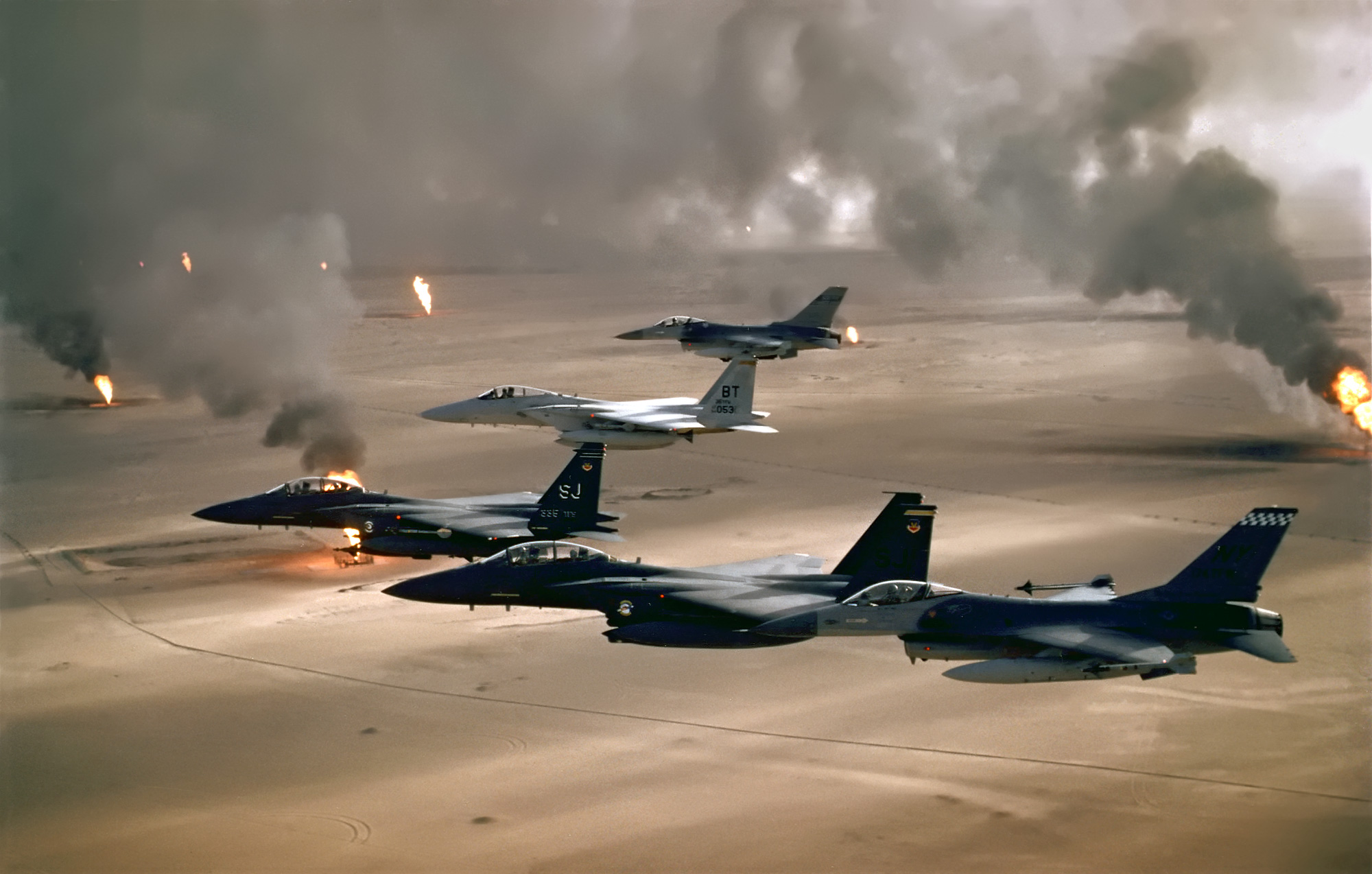
Gulf War air campaign
Operation Desert Storm, the combat phase of the Gulf War, began with an extensive aerial bombing campaign by the air forces of the coalition against targets in Iraq and Iraqi-occupied Kuwait from 17 January 1991 to 23 February 1991. Spearheaded by the United States, the coalition flew over 100,000 sorties, dropping 88,500 tons of bombs,[4] widely destroying military and civilian infrastructure.[5] The air campaign was commanded by United States Air Force (USAF) Lieutenant General Chuck Horner, who briefly served as Commander-in-Chief—Forward of U.S. Central Command while General Norman Schwarzkopf was still in the United States. The British air commanders were Air Chief Marshal Andrew Wilson (to 17 November 1990) and Air Vice-Marshal Bill Wratten (from 17 November).[6] The air campaign had largely finished by 23 February 1991 with the beginning of the coalition ground offensive into Kuwait.
The initial strikes were carried out by AGM-86 ALCM cruise missiles launched by B-52 Stratofortress bombers,[7] Tomahawk cruise missiles[8] launched from U.S. Navy warships situated in the Persian Gulf, by F-117 Nighthawk stealth attack aircraft[8] with an armament of laser-guided smart bombs,[8] and by F-4G Wild Weasel aircraft as well as F/A-18 Hornet aircraft armed with HARM anti-radar missiles.[9] These first attacks allowed F-14 Tomcat, F-15 Eagle, F-16 Fighting Falcon, and F/A-18 Hornet combat aircraft to gain air superiority over Iraq and then continue to drop television-guided and laser-guided bombs.
Armed with a GAU-8 rotary cannon and infrared-imaging or optically guided AGM-65 Maverick missiles, USAF A-10 Thunderbolt II's bombed and destroyed Iraqi armored forces,[8] supporting the advance of U.S. ground troops. United States Marine Corps close air support AV-8BHarriers employed their 25mm rotary cannon, Mavericks, cluster munitions, and napalm against the Iraqi dug-in forces to pave the way forward for the U.S. Marines breaching Iraqi President Saddam Hussein's defenses. The U.S. Army AH-64 Apache and AH-1 Cobra attack helicopters fired laser-guided AGM-114 Hellfire and TOW missiles which were guided to tanks by ground observers or by scout helicopters, such as the OH-58D Kiowa.[10] The Coalition air fleet also made use of the E-3A Airborne Warning and Control Systems and of a fleet of B-52 Stratofortress bombers.[8][9]
Civilian casualties[edit]
The U.S. government claimed Iraqi officials fabricated numerous attacks on Iraqi holy sites in order to rally the Muslim world to support Iraq during the conflict, pointing to Iraq's claim that Coalition forces had attacked the holy cities of Najaf and Karbala. At the end of the war, the estimated number of Iraqi civilians killed was 2,278 killed and 5,965 wounded.[55]
On 13 February 1991, a United States Air Force (USAF) warplane fired two laser-guided missiles at an air raid shelter in the Al-A'amiriya neighborhood of Baghdad, killing at least 408 civilians sheltering there. U.S. officials subsequently claimed that the shelter also served as a communications center for the Iraqi military. BBC correspondent Jeremy Bowen, who was one of the first television reporters on the scene, was given access to the shelter and claimed that he did not find any evidence of it being used by the Iraqi military.[56] His claims were later contradicted by Iraqi general Wafiq al-Samarrai, who claimed that the shelter was used by the Iraqi Intelligence Service, and that Saddam Hussein had personally made visits to it.[57] The day after the bombing of the shelter, a Royal Air Force (RAF) fighter jet fired two laser-guided missiles which were aimed at a bridge in Fallujah which was used as part of an Iraqi military supply line. The missiles malfunctioned and struck Fallujah's largest marketplace (which was situated in a residential area), killing between 50 and 150 non-combatants and wounding many more. After news of the mistake became public, an RAF spokesman, Group Captain David Henderson issued a statement noting that the missile had malfunctioned but admitted that the Royal Air Force had made an error.[58][59]
$_$_$DEEZ_NUTS#0__titleDEEZ_NUTS$_$_$
$_$_$DEEZ_NUTS#0__subtitleDEEZ_NUTS$_$_$
Losses[edit]
An estimated 407 Iraqi aircraft were either destroyed or flown to Iran and permanently impounded there.[3] During Desert Storm, 36 aircraft were shot down in aerial combat.[60] Three helicopters and 2 fighters were shot down during the invasion of Kuwait on 2 August 1990. Kuwait claims to have shot down as many as 37 Iraqi aircraft. These claims have not been confirmed.[61] In addition, 68 fixed wing aircraft and 13 helicopters were destroyed while on the ground, and 137 aircraft were flown to Iran and never returned.[62]
The Coalition lost a total of 75 aircraft—52 fixed-wing aircraft and 23 helicopters–during Desert Storm, with 39 fixed-wing aircraft and 5 helicopters lost in combat.[62] One coalition fighter was lost in air-air combat, a U.S. Navy F/A-18 piloted by Scott Speicher. Other Iraqi air to air claims surfaced over the years, all were disputed.[63][64] One B-52G was lost while returning to its operating base on Diego Garcia, when it suffered a catastrophic electrical failure and crashed into the Indian Ocean killing 3 of the 6 crew members on board. The rest of the Coalition losses came from anti-aircraft fire. The Americans lost 28 fixed-wing aircraft and 15 helicopters; the British lost 7 fixed-wing aircraft; the Saudi Arabians lost 2; the Italians lost 1; and the Kuwaitis lost 1. During the invasion of Kuwait on 2 August 1990, the Kuwaiti Air Force lost 12 fixed-wing aircraft, which were destroyed on the ground, and 8 helicopters, 6 of which were shot down and 2 of which were destroyed while on the ground.[61]